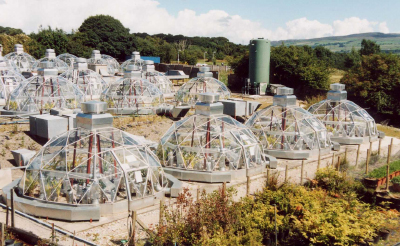Soils reveal global warming paradox

Solardomes
Forests may not be able to slow down global warming as effectively as previously thought due to rising Carbon Dioxide levels according to new research published on 9th September 2005 in the journal Science.
The research by a team of UK-based scientists from the Lancaster Environment Centre, home to scientists from both Lancaster University and the Centre for Ecology & Hydrology, and the University of York, found that as CO2 levels rise, the potential of forest soils to absorb atmospheric CO2 - and thereby slow down global warming - may be much less than previously thought.
The Natural Environment Research Council funded experiment was carried out on young trees in Lancaster University's prominent "Field of Solardomes" that used to overlook the M6 motorway.
Dr James Heath of Lancaster University said: "This is the first study using a wide range of tree species to show that, while trees may take up more CO2 as CO2 levels in the atmosphere rise, less may end up being stored in the soil.
"A huge amount of CO2 is exchanged between the atmosphere and forest ecosystems every year. Even a small shift in this balance could have a large impact on the concentration of CO2 in the air."
Levels of CO2 - the chief greenhouse gas from human activities - have been steadily rising since the industrial revolution, mainly due to the burning of fossil fuels.
The study warns that the potential of terrestrial ecosystems to absorb the increasing amounts of CO2 that we add to the atmosphere every year- and thereby slow down global warming - may be considerably smaller in a future "high CO2 world" than previously thought.
The researchers planted over 500 young trees of six species in eight tonnes of specially treated soil in twelve of the solardomes, and measured the amount of carbon that the trees were removing from the atmosphere and transferring to the soil over two years. The domes were filled with air at one of four different CO2 levels. One group was at current CO2 levels (around 380 parts per million) and the other three groups were at around 480, 580 and 680 parts per million. These are the CO2 concentrations expected to be reached at different points within the next 100 years.
Although a significant quantity of new carbon was retained in the soil beneath all trees, scientists discovered that with increasing CO2 concentration less new carbon was retained in the soil - the converse of what was expected. It was assumed that under higher CO2 conditions the trees would grow faster and release more carbon into the soil via the roots and that therefore, more carbon would be retained in the soil. The experiment showed that this may not be the case, because at increased CO2 concentrations more of the extra carbon transferred to the soil by the tree roots was simply released back into the atmosphere through the respiration of soil micro-organisms.